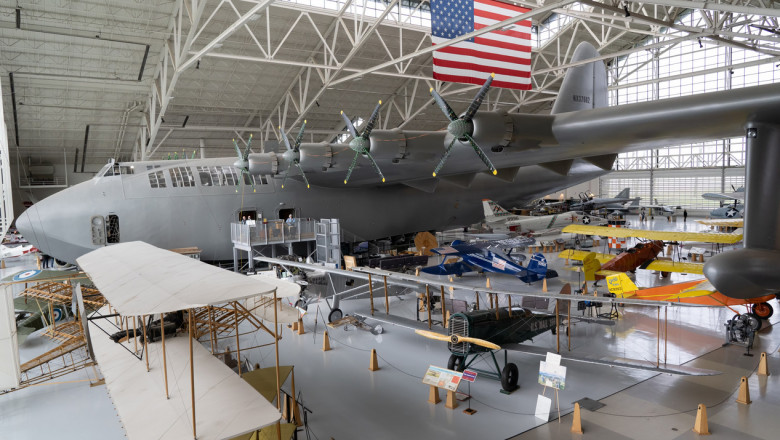
views
Flight of the Spruce Goose
Why The Spruce Goose Only Flew Once
In an industry where size matters, the largest aircraft are often the ones that most strongly capture the hearts and minds of both aviation enthusiasts and the general public. At the time of its construction, the Hughes H-4 Hercules, familiarly known as the Spruce Goose, was the world's largest plane. However, it was built for a war that was already over and never found a place in our modern world.
November 2nd, 2022 marked 75 years since the Spruce Goose flew for the first and last time. During this period in the immediate postwar era, the Spruce Goose plane had the biggest wingspan in the world, at 320 feet and 11 inches (97.82 meters). A flying boat that had eight engines and weighed 400,000 pounds (181,436 kg), it would be able to carry more cargo than anything else ever conceived.
The Spruce Goose's specifications included a cruising speed of 250 mph (400 km/h), and a range of 3,000 miles (4,800 km or 2,600 NM). In terms of passenger capacity, it was planned to seat some 750 occupants, and was flown by a three-person crew. Its length and height were 218 feet and 8 inches (66.65 meters) and 79 feet and 4 inches (24.18 meters) respectively, making it a veritable colossus.
The Hughes H-4 Hercules' nickname of 'Spruce Goose' was derived from the fact that the enormous aircraft was built primarily of wood. This was a result of wartime restrictions on the use of aluminum, as well as weight concerns. As pictured above, this resulted in its interior looking more like a boat than an aircraft.
In 1942, against the violent backdrop of the ongoing Second World War, the United States Navy was losing ships to German U-boats in the Atlantic Ocean. As a result of this, it needed a way to transport its troops and supplies to Europe by air. Subsequently, shipbuilder Henry J. Kaiser came up with the idea to work with the famous plane designer Howard Hughes to create the largest aircraft ever built.
Dubbed the HK-1, it would be able to carry up to 150,000 pounds (68,000 kg) of materials, 750 troops, or two 30-ton M4 tanks. Different concepts were considered, including a double fuselage with up to eight engines. The wood used to build the plane was a particular composite of plywood and resin made from Birchwood.
Alas, the aircraft would take so long to design and build (thanks to Howard Hughes' perfectionism) that Kaiser would abandon the project. Hughes would continue the project in his absence and rename it the H-4 Hercules. The military downscaled the project at the end of the war and reduced the program to a single prototype that would eventually go on to make just a single flight before retiring.
Construction of the colossal aircraft eventually finished at the cost of $23 million ($306 million today) in 1947. By this time, the Second World War was already two years in the past, having come to an end in 1945. On November 2nd, 1947, the plane underwent water taxi tests and, on the final test, took off for a brief 26 seconds for a mile (1.6 km) at an altitude of 70 feet (21 meters) above the water.
Alas, without government support or use, the plane would then sit in a hangar with its full capacity unused. Despite being fully built, it had no purpose, and further testing was unneeded. Amid amplified concerns about national expenditure, Hughes was summoned to appear before a Senate Committee in 1947, telling them:
"The Hercules was a monumental undertaking. It is the largest aircraft ever built. It is over five stories tall with a wingspan longer than a football field. That's more than a city block. Now, I put the sweat of my life into this thing. I have my reputation all rolled up in it, and I have stated several times that if it's a failure, I'll probably leave this country and never come back. And I mean it."
The airframe of the retired Hughes H-4 Hercules was previously on display in Long Beach, California, between 1980 and 1992. Owing to its incredibly short operational life, and careful climate-controlled preservation in the years that followed, the Spruce Goose has remained in a good condition. Today, it can be seen by visitors at the Evergreen Aviation & Space Museum in Oregon, USA.
The H-4 held the wingspan record until recent years, when the double-Boeing 747 fuselage Stratolaunch took to the skies, channeling the inner spirit of the Spruce Goose. Moreover, When it comes to everyday aviation, the Antonov An-225 ruled when it came to size until it was destroyed in Russia's invasion of Ukraine.
With six engines, the Scaled Composites Model 351 Stratolaunch is a double fuselage unit and has the largest wingspan of any aircraft in history, measuring 117 meters (384 feet). Like the Spruce Goose, the program has also been met with several challenges, and a test flight was abandoned after unexpected results.
Nonetheless, From the Spruce Goose to the Stratolaunch, these juggernauts will always turn heads when spotted. The H-4 Hercules may not have seen much action, but it's an example of the pioneering nature that is embedded in the aviation industry. It will be interesting to see what giants the future of aviation has in store.
What are your thoughts about the H4-Hercules? What do you make of the aircraft's overall size? Let us know what you think of the plane and its history in the comment section.
The leading independent voice for aviation news and insight.




















Comments
0 comment